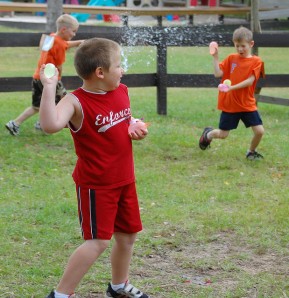10 Ways to Play With. . . Part 4 of 4
Many of the children we see at our clinics have difficulty with motor planning. Motor planning is a complex skill which allows a person to generate an idea for a motor action, efficiently time and sequence the movements necessary, grade the force required, and execute the action. Children who have a hard time with the ideation phase of motor planning may tend to play the same activities over and over or struggle to come up with multiple solutions to a problem. Open-ended free play is a great way to stretch this ability; however, a child who truly has a motor planning deficit will likely need some guidance and encouragement along the way. Here are some suggestions to help you look at novel ways to play with toys or items you may already have in your home. As you’re playing, ask your child questions like “What else could this be?” and praise their efforts to think outside the box.
10 Ways to Play with a Beach Ball
- Set up a goal to kick the ball into, or for something new, challenge your child to use a different body part, like an elbow, to knock the ball into the goal.
- Grab a laundry basket and play a target game.
- Take on a multi-step challenge. The first person picks an action, such as bouncing the ball one time. The next person bounces the ball one time, and then adds a step, like turning around holding the ball. The game continues, adding on more and more steps. How many can you remember?
- Set up an obstacle course to maneuver the ball through.
- Kangaroo kicks: Have your child lie down on his back and prop up his body on his elbows. Stand a few feet away (more if you have a child who tends to use too much force) and toss the ball for him to kick with the soles of his feet back to you.
- Write sensory diet activities recommended by your therapist on different areas of the ball. Toss the ball back and forth a few times, then do the action written on the area facing upward.
- Stand up some blocks and go bowling.
- Play the game ”keep it up”. How many times can you tap the ball up before it falls to the ground?
- Team work relay. Can your child and a friend work together to get the ball across the room by holding the ball between their hips? Behind their backs?
- Pool noodle hockey. Have any pool noodles that survived the summer? Repurpose them into hockey sticks for the beach ball.









